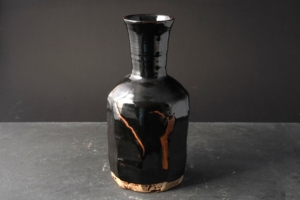Ash & Crackle
Ash-based glazes utilise and contain a variety of different wood ashes. The “cracked” look is achieved during the cooldown phase. This is due to the outer glaze contracting more than the inner glaze and thus causing micro cracks in the outer glaze.
Copper Red
(Ox Blood) Highly reactive copper oxide within a glaze is often fired in so-called saggers, which are boxes constructed of fire clay. The color of these saggers transforms during the firing process from green to this distinctive red.
Celadon
Celadon is a European term for pottery that is referred to as “green ware“ in China. This European term is derived from the name of the hero of Honoré d´Urfé ´s novel “L´ Astrreé“ (1610). The color of the shepherd Celadon delicate green garment became fashionable as soon as the hero’s name was attached to that color. A tiny amount of iron oxide in the glaze results in this delicate green color.
Tenmoku
This glaze was originally known as Jian-Blackchina from the Fujiam province in China. The name Tenmoku originates from the Tianmu mountain (eye of the sky). Tenmoku is a glaze which is very rich in iron. This brings about the well-known oil stain-, tea dust-, and part-ridge-patterns, which give this glaze it’s special and unique look.
Shino
This term, established in the 16th century, is often linked to the tea master Shino Soshin. Here a white feldspathic glaze with uneven thickness is used to achieve small pinholes and cracks (also known as “lemon skin”).
Chün (Jun)
Extremly tiny glass spheres embedded in the glaze dominanth scatter blue light, an optical effect similiar to why the sky appears blue. This type of glaze is completely free of metal oxides. This glaze can be supplemented with dashes of red copper pigments, resulting in spectacular color contrasts. The pigments can also diffuse through the clay during the firing process to appear on the side opposite to where they were applied, resulting in unexpected but interesting color contrast effects.






